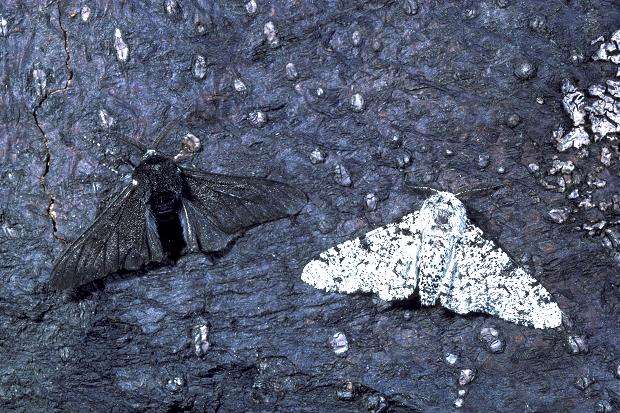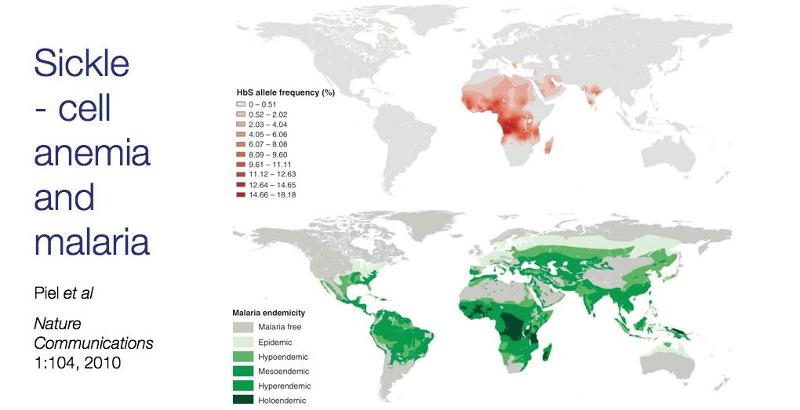Mutations Drive Evolution
The 3 billion base pairs in the human genome are remarkably similar from one person to another, but over tens of thousands of years random mutations in genes have introduced many variants. We saw previously that mutations can result in
- inconsequential changes which do not alter the protein product
- small changes that alter the protein product to some degree, e.g., an enzyme that is somewhat more efficient in catalyzing a biochemical reaction
- small changes that alter phenotype markedly, e.g., the single base substitution that results in sickle cell disease
- very large changes in the base sequence that arise from insertion or deletion of a base pair or relocation of a segment of nucleotides
Depending on the function of the gene and the magnitude of change, a mutation may or may not be compatible with life. A fetus with a critical mutation may be unable to survive, leading to a miscarriage (spontaneous abortion). Non-fatal mutations can result in protein alterations that alter characteristics like hair or eye color, or they can produce proteins that function better or worse than the usual protein. All of these accumulated differences in genes are what distinguish one person from another and make each of us unique. (Identical twins are born with exactly the same genome, but a host of environmental and epigenetic factors produce differences even in identical twins.)
These occasional random mutations are responsible for driving the evolution of species by sometimes conferring a survival advantage. Consider two brief examples:
- When penicillin was first introduced, Staphylococci infections were quickly defeated by small doses, but at some point in time the bacterial DNA underwent a mutation that made a particular Staphylococcus resistant to penicillin. Treatment with penicillin killed at of the other Staphylococci, which were sensitive, but the resistant bacterium survived and continued to divide giving rise to a growing colony of resistant bacteria. These mutant bacteria had a survival advantage, not only because they were resistant to penicillin, but also because they didn't have to compete with the sensitive bacteria for space and nutrients.
- The light-colored pepper moth was the predominant form in England prior to the industrial revolution, but a dark-colored peppered moth appeared during the Industrial Revolution, and by 1895 98% of the moths in the industrialized areas of England were dark. Coal was the primary energy source during the industrial revolution, and the enormous increase in its use resulted in huge dark, sooty clouds in and around London and Manchester. These clouds were extensive enough to block sunlight, and they also deposited black coal dust on the bark of trees. This apparently put light-colored pepper moths at a disadvantage, because the black bark made them more visible to birds which fed on the moths. It is believed that at some point a mutation occurred that resulted in dark-colored pepper moths, and these had a survival advantage, because they blended in with the dark, soot stained bark. These dark moths had a distinct survival advantage in this environment, and on and Manchester. Tree bark became blackened, and the dark moth was more difficult for birds to see, giving it a survival advantage. The dark moths were less likely to be eaten and therefore they had more opportunity to reproduce compared to the light moths. As a result of this survival advantage, 98% of the moths in London and Manchester were dark-colored by 1895. Since then, reduced use of coal has slowly resulted in lighter bark, and the light-colored moths are now found in greater numbers.

Source: http://www.openwindowlearning.com/quizzes/the-role-of-genetic-diversity-in-evolution/
Natural Selection
Charles Darwin postulated that if a mutation confers some advantage (e.g., resistance to penicillin, or better camouflage, or faster muscles, etc.) than those organisms will be better able to compete in an environment with limited resources or other environmental pressures (such as penicillin or predatory moths). These "fitter" organisms will therefore have more opportunity to thrive and reproduce, and their numbers will increase. As a result, the frequency of the mutant gene will increase in the organisms in the particular environment that gives those with the mutation an advantage.
Darwin's Postulates
- With limited resources, reproduction generates more individuals than are able to survive and reproduce.
- The disparity between resources and numbers generated by reproduction creates a competition for survival.
- Variants with advantageous features are more likely to survive and reproduce.
- Variants with survival advantages pass their traits to their offspring.
The Prevalence of Sickle Cell Trait
Having an allele for the sickle cell form of hemoglobin would seem to be a bad thing, but that depends on both the genotype and the environment. The gene for sickle cell disease follows a Mendelian pattern of inheritance (described briefly on page 11). The allele for sickle cell hemoglobin is designated HbS, and there are several genotypes that are possible:
- HbA-HbA: normal
- HbA-HbS: heterozygous; have sickle cell "trait"
- HbS-HbS: homozygous HbS; have sickle cell disease
Those who are homozygous for HbS have significant health problems and poor outcomes, but those who are heterozygous only have clinical manifestations under certain circumstances when the oxygen concentrations in blood dip, e.g., in high altitudes or with heavy physical activity. Without these stresses, heterozygous persons function normally. In fact, heterozygous HbA-HbS individuals have an advantage in locations where malaria is endemic, because their red blood cells are fragile and tend to lyse (fall apart), when infected with malaria. As a result, heterozygous individuals have a survival advantage in areas where malaria is endemic, and given this survival advantage the sickle cell allele tends to persist in environment where malaria is endemic as demonstrated by the graphic below which shows the prevalence of the sickle cell allele in the top panel and prevalence of malaria below.

Source: Piel et al.: Nature Communications1:104, 2010


